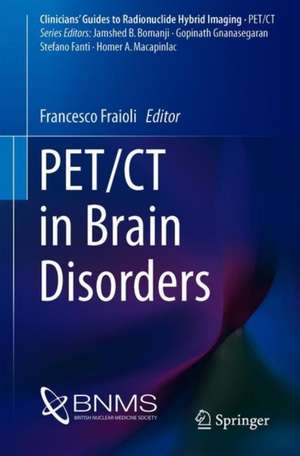PET/CT in Brain Disorders: Clinicians’ Guides to Radionuclide Hybrid Imaging
Editat de Francesco Fraiolien Limba Engleză Paperback – 13 mar 2019
Din seria Clinicians’ Guides to Radionuclide Hybrid Imaging
- 5%
 Preț: 363.79 lei
Preț: 363.79 lei - 5%
 Preț: 357.97 lei
Preț: 357.97 lei - 5%
 Preț: 453.68 lei
Preț: 453.68 lei - 5%
 Preț: 517.86 lei
Preț: 517.86 lei - 5%
 Preț: 452.59 lei
Preț: 452.59 lei - 5%
 Preț: 359.42 lei
Preț: 359.42 lei - 5%
 Preț: 582.24 lei
Preț: 582.24 lei - 5%
 Preț: 550.33 lei
Preț: 550.33 lei - 5%
 Preț: 454.51 lei
Preț: 454.51 lei - 5%
 Preț: 480.20 lei
Preț: 480.20 lei - 5%
 Preț: 331.79 lei
Preț: 331.79 lei - 5%
 Preț: 323.47 lei
Preț: 323.47 lei - 5%
 Preț: 416.85 lei
Preț: 416.85 lei - 5%
 Preț: 416.85 lei
Preț: 416.85 lei - 5%
 Preț: 421.19 lei
Preț: 421.19 lei - 5%
 Preț: 449.87 lei
Preț: 449.87 lei - 5%
 Preț: 328.47 lei
Preț: 328.47 lei - 5%
 Preț: 512.57 lei
Preț: 512.57 lei - 5%
 Preț: 515.89 lei
Preț: 515.89 lei - 25%
 Preț: 268.74 lei
Preț: 268.74 lei
Preț: 520.60 lei
Preț vechi: 548.01 lei
-5% Nou
Puncte Express: 781
Preț estimativ în valută:
99.61€ • 104.01$ • 82.45£
99.61€ • 104.01$ • 82.45£
Carte disponibilă
Livrare economică 15-29 martie
Preluare comenzi: 021 569.72.76
Specificații
ISBN-13: 9783030015220
ISBN-10: 303001522X
Pagini: 170
Ilustrații: XVII, 178 p. 82 illus., 72 illus. in color.
Dimensiuni: 155 x 235 mm
Greutate: 0.27 kg
Ediția:1st ed. 2019
Editura: Springer International Publishing
Colecția Springer
Seriile Clinicians’ Guides to Radionuclide Hybrid Imaging, PET/CT
Locul publicării:Cham, Switzerland
ISBN-10: 303001522X
Pagini: 170
Ilustrații: XVII, 178 p. 82 illus., 72 illus. in color.
Dimensiuni: 155 x 235 mm
Greutate: 0.27 kg
Ediția:1st ed. 2019
Editura: Springer International Publishing
Colecția Springer
Seriile Clinicians’ Guides to Radionuclide Hybrid Imaging, PET/CT
Locul publicării:Cham, Switzerland
Cuprins
Introduction to Brain Disorders.- Radiological imaging in Brain disorders.- PET tracers for brain imaging.- 18F-FDG PET-CT: Brain Imaging.- 18F-FDG PET/CT in Neuro degenerative disease.- 18F-FDG PET/CT in Movement disorders.- 18F-FDG PET in Epilepsy.- PET/CT in Neuro-oncology.- 18F-FDG Pitfalls and Limitations of PET/CT in Brain Imaging.- Clinical applications of Non 18F-FDG PET-CT Tracers in brain imaging.- Amyloid PET Imaging of the brain.- PET/CT-Based Radiotherapy Planning in Brain Tumours.- Clinical applications of PET/MRI in brain Imaging.- Clinical atlas of Brain PET-CT.
Notă biografică
Francesco Fraioli is a dual-trained radiologist and nuclear medicine physician with a special interest in oncology and neuroimaging. He is Associate Professor t in Metabolism & Experimental Therapeutics at the Faculty of Medical Sciences, University College London (UCL) and a medical consultant and radiologist at the UCL Hospital. Since his appointment at UCL he has focused on several brain domains, including dementia, brain tumours, PET/MRI and new tracers. With the aid of recognized colleagues, and under the auspices of the British Nuclear Medicine Society, Dr. Fraioli has developed this pocket guide to brain imaging, the main aim of which is to assist radiologists and nuclear medicine physicians in dealing with the most common brain disorders during daily clinical practice. A wide range of images have been collected with the intention of providing a reference atlas for all who work in neuro-imaging.
Textul de pe ultima copertă
This well-illustrated pocket book offers up-to-date guidance on the clinical and research applications of PET/CT in the most common neurological and neuro-oncological disorders. The opening chapters cover the pros and cons of widely used radiological imaging techniques, scanners, and radiopharmaceuticals, with emphasis on the state of the art hybrid modalities, primarily PET/CT but also PET/MRI. Helpful information is provided on the clinical and research tracers used in neurodegenerative diseases, movement disorders, epilepsy and brain tumours. These four killers are then discussed in detail, highlighting the role of PET/CT and targeted tracers in their assessment and in radiotherapy planning. In addition, the clinical applications of PET/MRI are considered. Throughout, many images are included to better explain the diseases and the role of hybrid imaging, and the final chapter presents a large sample of teaching cases and files that will assist in daily clinical practice. The book has been compiled under the auspices of the British Nuclear Medicine Society. It will be an excellent asset for nuclear medicine physicians, radiologists, radiographers, neurologists and neurosurgeons.
Caracteristici
Covers both clinical and research applications of PET/CT Presents numerous images of help in daily clinical practice Written by leading experts in the field
